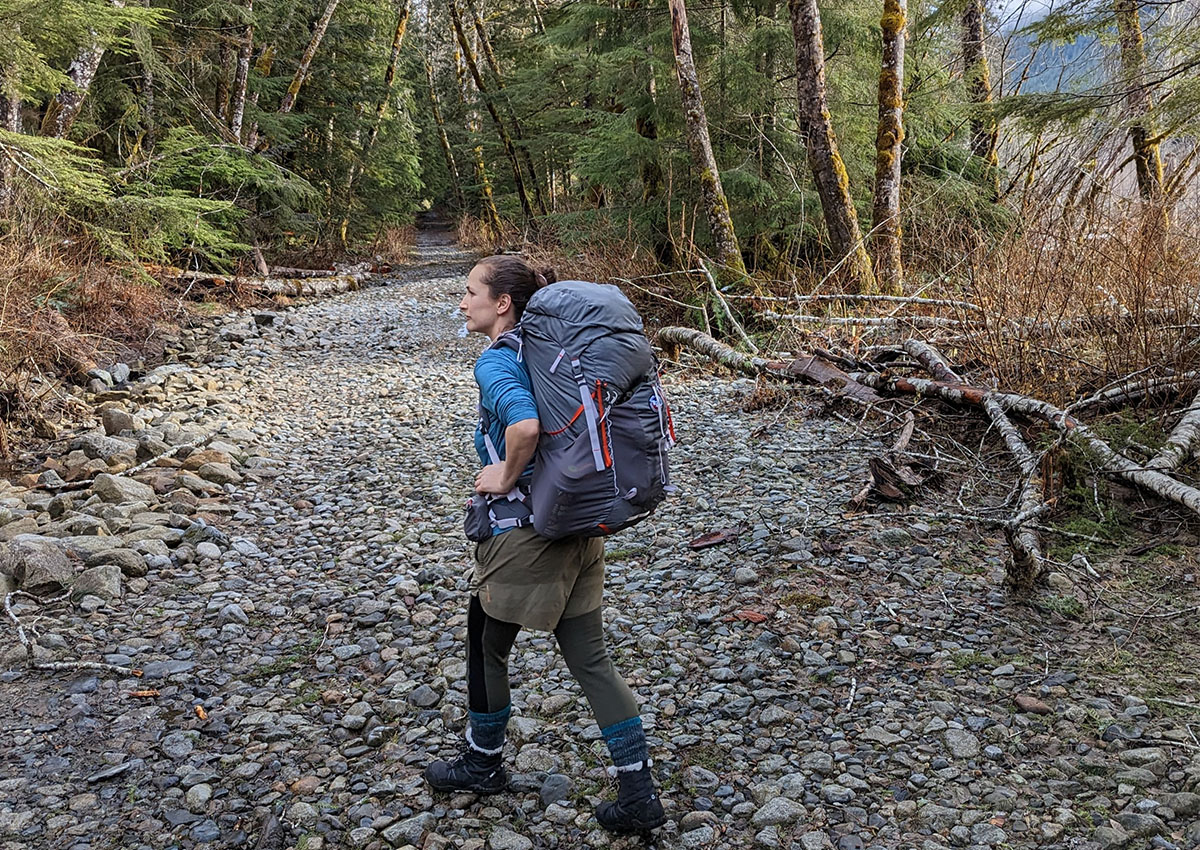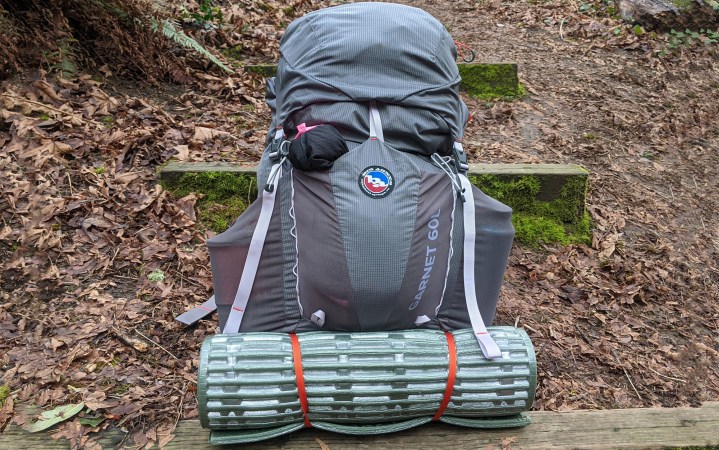We may earn revenue from the products available on this page and participate in affiliate programs. Learn More ›
See enough ultralight backpackers deep in the backcountry with nonexistent hip belts on their frameless 30L packs and you eventually start to wonder: Should I be doing that? But if you’re used to a robust suspension system and all the pockets and features of a traditional backpack, making the switch can be daunting, and sometimes just a flat-out mistake. The Big Agnes Parkview and Garnet split the difference between the traditional and UL camps by pairing a robust frame with a number of removable features, so backpackers can experiment with going lightweight at their own pace.
Big Agnes Parkview and Garnet Specs and Key Features
- Parkview Capacity: 63 liters (can expand to 73 liters)
- Garnet Capacity: 60 liters (can expand to 67 liters)
- Weight: 3.5 pounds to 4.1 pounds
- Parkview Torso Fit: 18 to 22 inches
- Garnet Torso Fit: 16 to 18 inches
- Fabric: Ripstop nylon, twill fabric bottom
- Frame: Injection-molded plastic with aluminum core
- Pockets: Removable top lid pockets, two side stretch pockets, front mesh pocket with internal zip pocket, two removable hip belt zip pockets
- Adjustment Points: Attached hip belt, shoulder straps, load lifters, adjustable back panel, sternum strap
- Bladder Compatible: Yes
- Bear Can Compatible: Yes, including horizontal (tested with a Bear Vault 500 and Counter Assault Bear Keg)
- Comfortable up to 45 pounds (as reported by the testers)
At just over 3.5 pounds, the Big Agnes Parkview and Garnet are on the lighter side for traditional backpacks but a hair too heavy to be considered a true lightweight pack. While these packs are tricked out with many (although not all) of the usual pockets, trekking pole attachments, and compression straps, several of these features can be removed entirely via simple plastic buckles for an even lighter setup.

About This Backpack Test
With plenty of backpacking gear, it’s possible to quantify what the “best” products are in any category. The best backpacking water filters need to be able to perform reliably across a wide variety of water sources. The best tent stakes need to have great holding power at a low weight. The best bear cans need to be able to keep bears out of your food. But what makes for the best backpacking backpack is more subjective.
First you have to consider everything you are carrying: a 20-pound overnight load carries a lot differently than 40 pounds of gear for a weeklong trip. Then there is how you pack that gear into your pack—do you use a water bladder or Nalgenes? Are you carrying lots of layers that you’ll need easy access to, or are you hiking in a fair-weather climate? But the biggest X factor of all is you: the padding, hip belt length, torso width, and shoulder strap curve all vary between backpacks, and choosing a backpack that’s wrong for your frame can result in everything from back pain to bruising.
To help find the best backpacking backpack for each body type, we selected a panel of testers across a wide range of body types and experiences, who will test a series of backpacks throughout the year. Once all bags are tested we’ll pool the results into a best backpacking backpacks article.
Our Testers
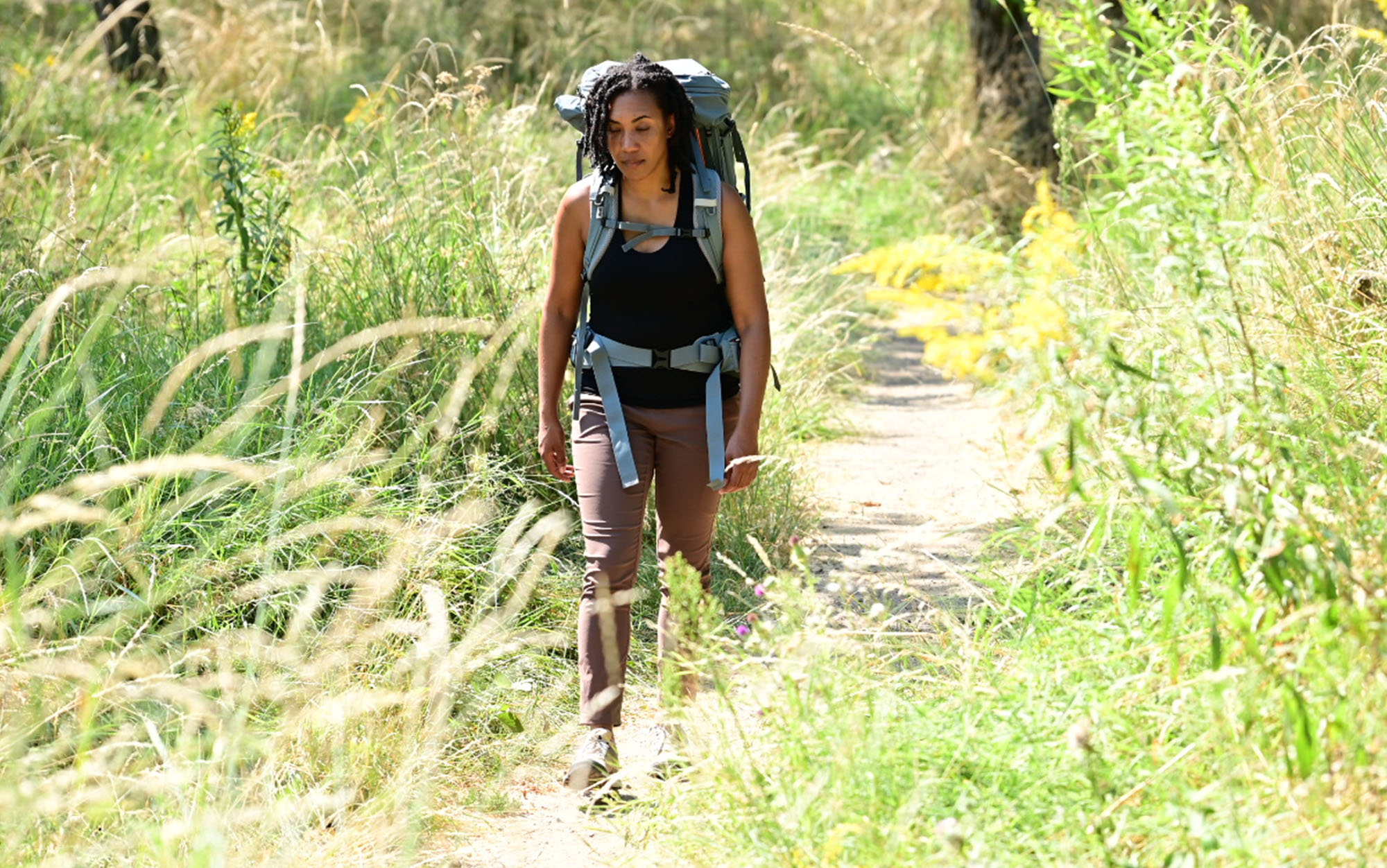
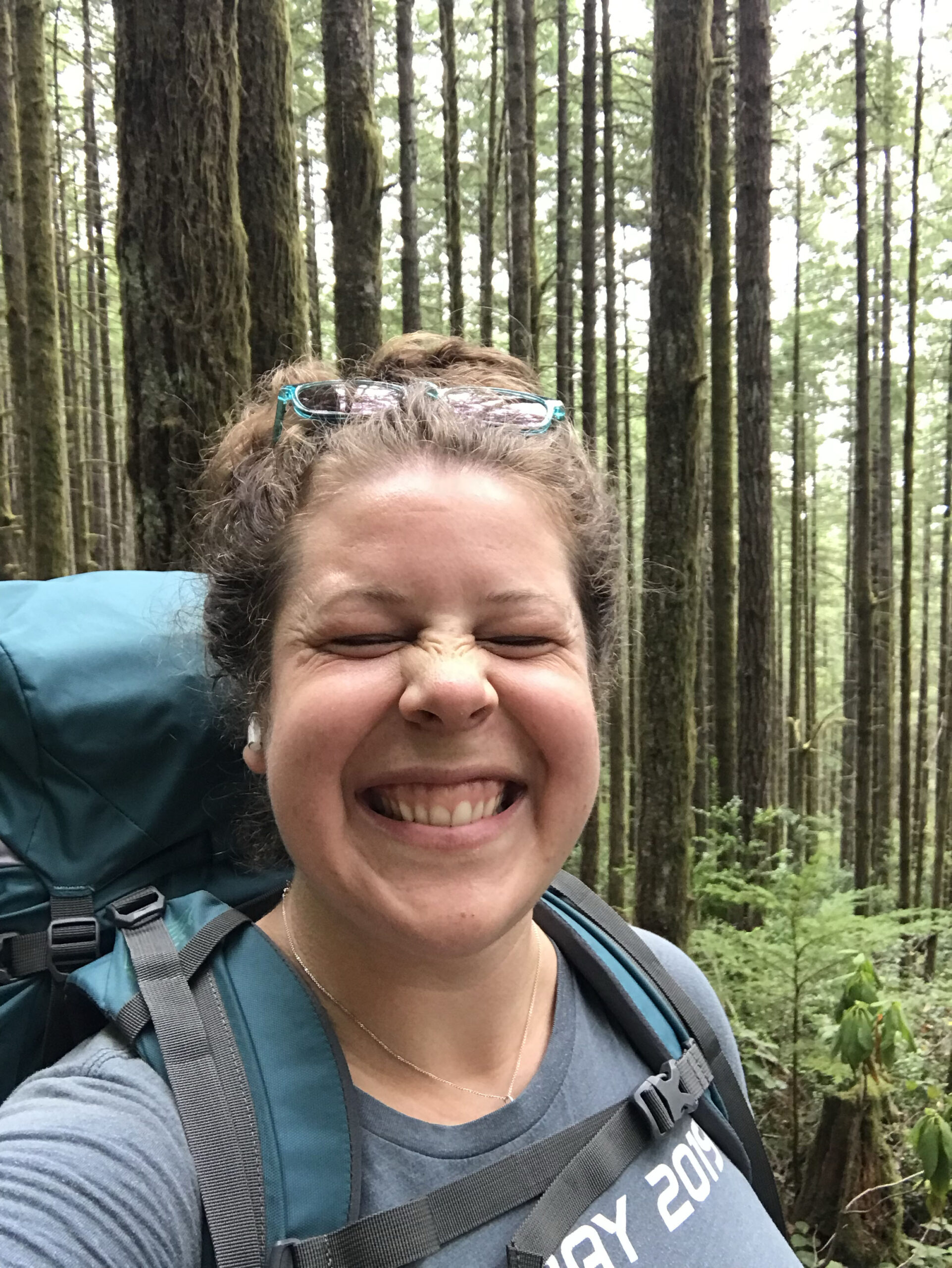
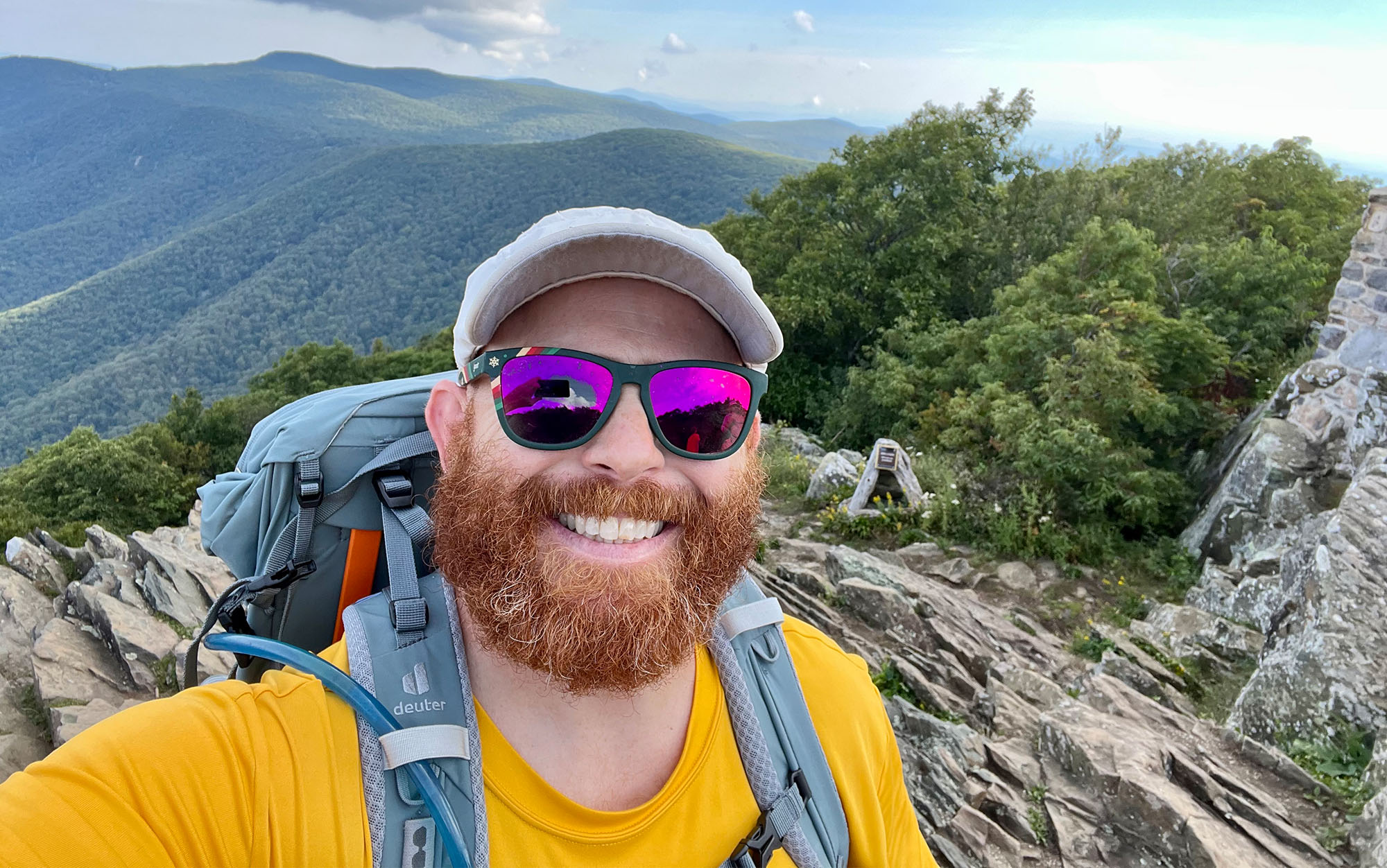
Rebecca Ross is a backpacker, climber, mountaineer, and runner who is a staff writer for GearJunkie and has contributed to Climbing magazine, and Melanin Base Camp.
Diana Helmuth has hiked extensively throughout the western U.S., Europe, and Chile and is the author of How to Suffer Outside, which won a National Outdoor Book Award.
Jason Boyle has been backpacking, hiking, and trail running for 30 years and currently works as a guide for REI out of Shenandoah National Park.
Testing the Big Agnes Parkview and Garnet in the Field
Our testers were all impressed by the load-bearing capabilities of the Big Agnes Parkview and Garnet, but the stiffer construction of this pack was a challenge when dialing in the fit.
| Category | Rebecca | Diana | Jason | Average |
| Fit: Could you adjust it to your satisfaction? | 4 | 5 | 8 | 5.7 |
| Comfort: Did the pack cause you any pain or discomfort? | 5 | 5 | 8 | 6 |
| Load Bearing: How did it handle a heavy load? | 7 | 10 | 8 | 8.3 |
| Storage: Did the pack adequately hold all your gear? | 9 | 6 | 8 | 7.7 |
| Accessibility: How easy was it to access all your gear in the field? | 9 | 7 | 6 | 7.3 |
| Value: Is it worth the money? | 9 | 5 | 8 | 7.3 |
| Overall | 8 | 6.3 | 7.9 | 7.4 |
While Jason had no trouble adjusting the Parkview version of this pack to his torso length, both Diana and Rebecca, who are on the high and low end of the Garnet’s torso length struggled to adjust the pack in a way that minimized pain points while field testing.
Fit, Comfort, and Load Bearing
The back panel for the Big Agnes Parkview and Garnet starts with a single solid piece of plastic. There are three slots on each side of the back panel for the shoulder straps, with an inch in between. You can move the connection point of the backpack straps—a metal tab—between these slots, depending on the length of your torso.
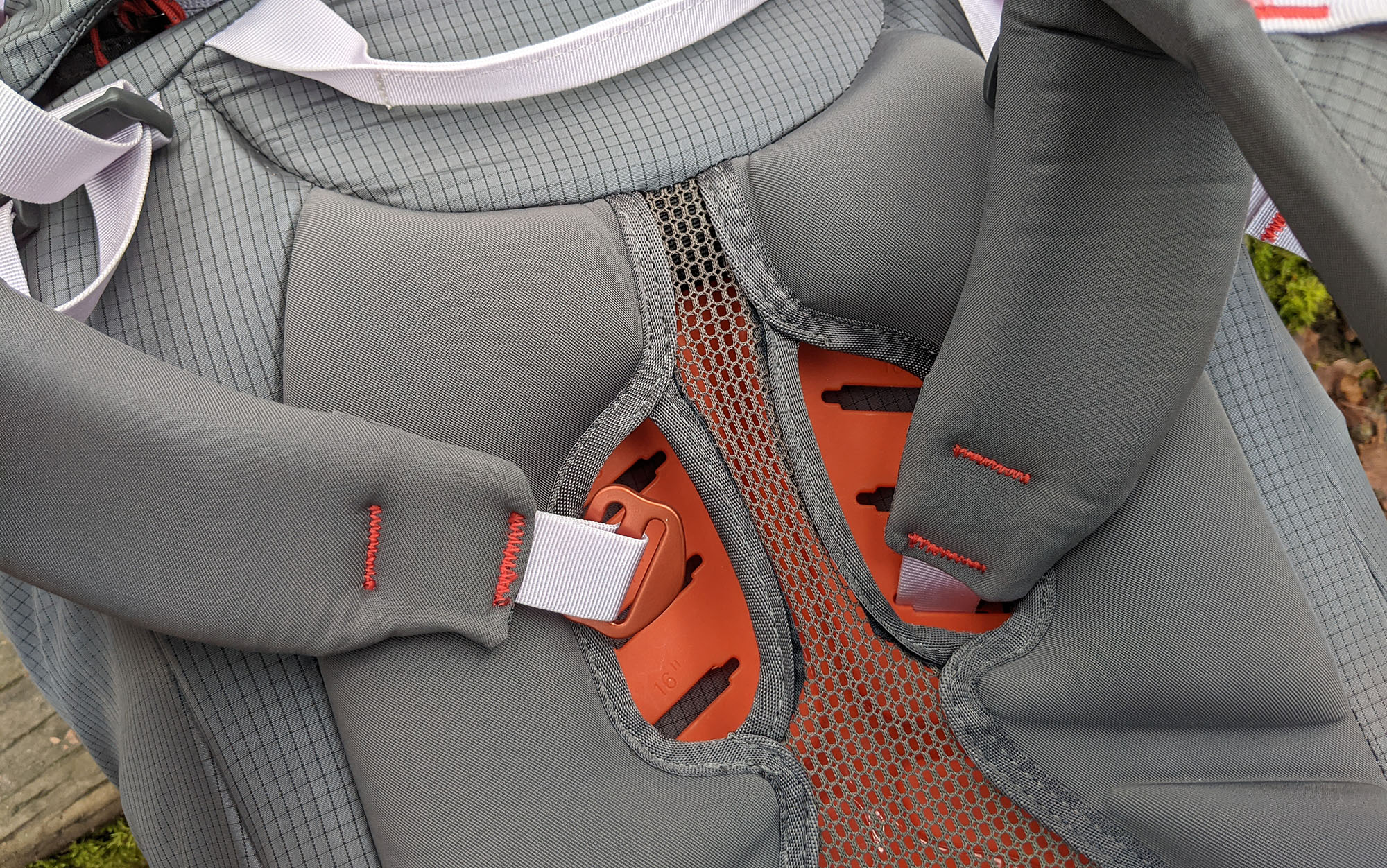
While this may be limiting for users who have an in-between torso length, the connection points for the shoulder straps do not shift around at all while backpacking, no matter how fully loaded the pack is. In practice, none of the testers—including Diana, whose torso length is a half-inch longer than the highest setting on the women’s pack—experienced issues when adjusting the shoulder straps. Covering the plastic frame is a cushioned back panel with a center mesh overlay, similar to other of the best backpacking backpacks, including the Kelty Coyote and the Deuter Aircontact.
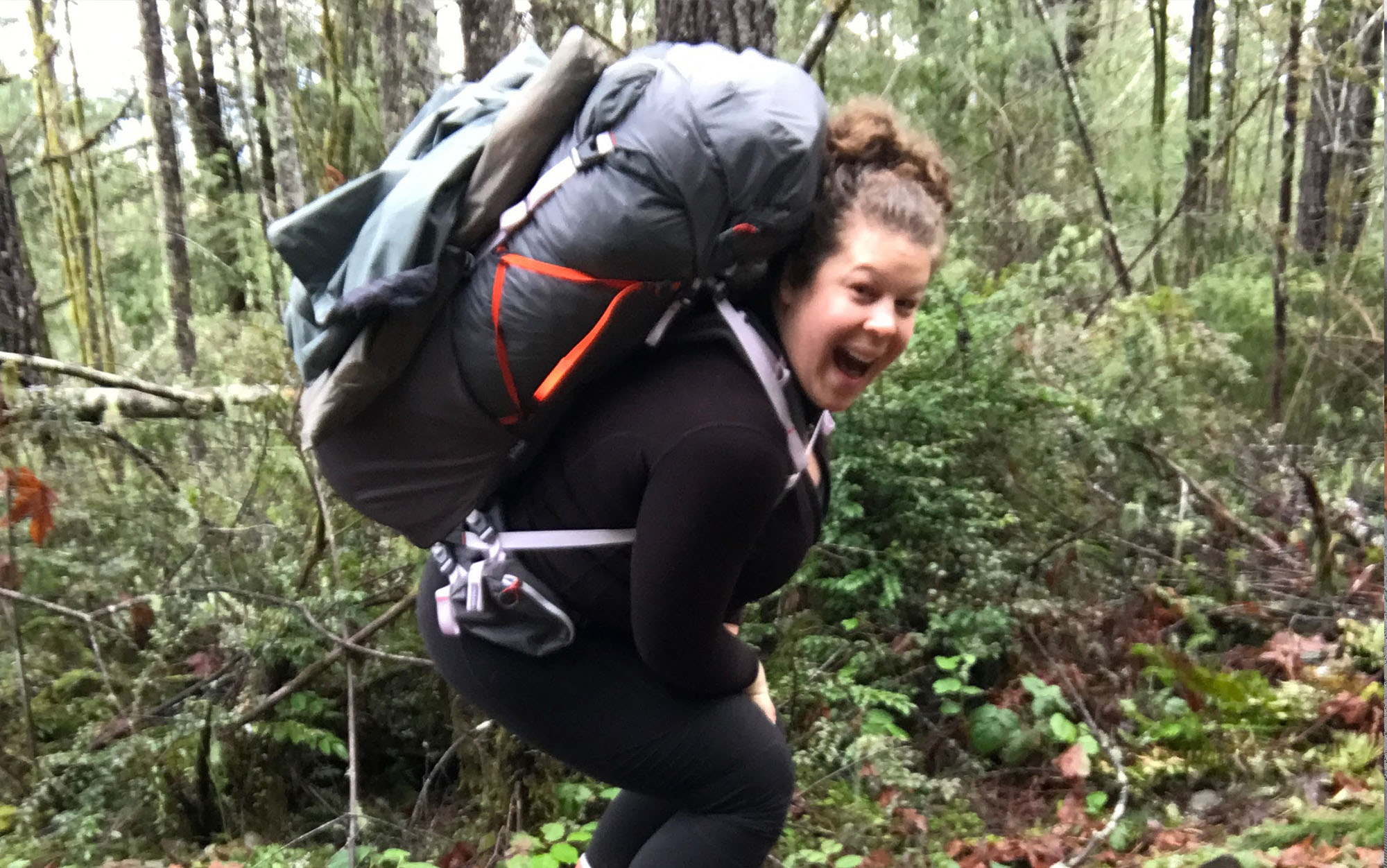
What most impressed the testers about this pack was its load-carrying capacity. Even when they struggled to balance the weight to their satisfaction while packing, once it was on their backs they barely noticed a thing. When Diana adjusted the load lifters, “it immediately felt like the weight was floating on me.” Jason similarly noted the pack’s ability to handle heavier weights after he carried forty pounds for four days in Shenandoah National Park: “It swallowed gear with ease, and carried well.”
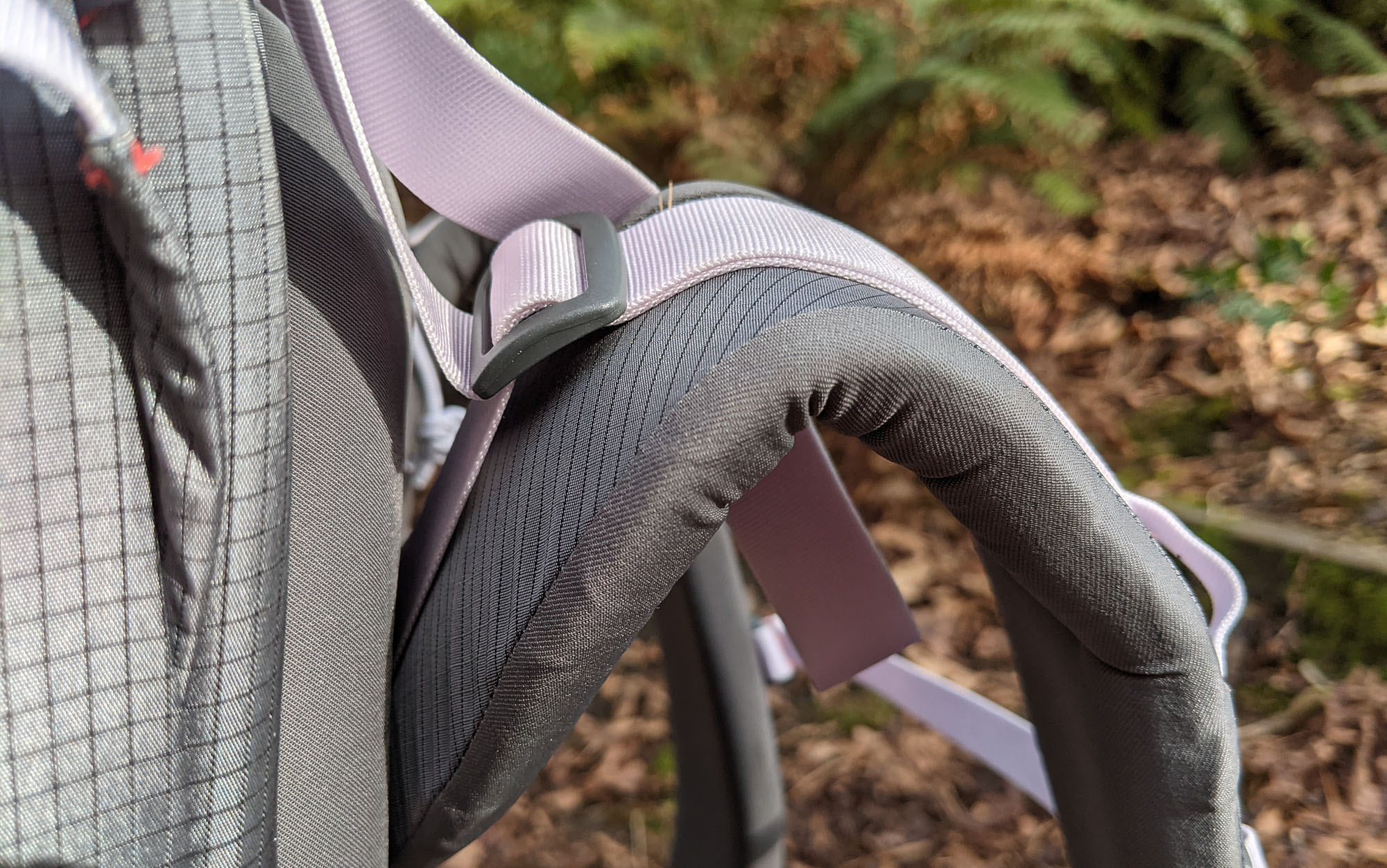
Unfortunately, the shoulder straps themselves are quite stiff out of the box, something both Diana and Rebecca reported issues with. For Rebecca, whose frame is on the small side, “the shoulder straps felt too close together. My first impression was that they were stiff, rigid, and uncomfortable. After a few minutes of trying it on, the amount of pressure and friction made it feel like hours of fatigue.” On the other end of the spectrum, Diana found that the straps were “digging painfully” into her arms and armpits (she also noted that she had the sternum strap nearly maxed out). While Jason did not report any issues with the shoulder straps, he did note that after 130 miles of backpacking with the Parkview, the shoulder straps were still stiff.
The hip belt of the Big Agnes Parkview and Garnet is similarly stiff; however, all three testers reported that it was comfortable, and that it sat most comfortably when it was higher up on their hips than they were accustomed to. Diana also noted that the hip belt was a good fit for her frame compared to other backpacking backpacks, and that the hip belt pockets were easy to reach. While Jason found that the hip belt was almost too large for his frame, Rebecca did not report this issue—men who are too narrow for the Parkview hip belt should try out the Garnet to see if it works better with their frames.
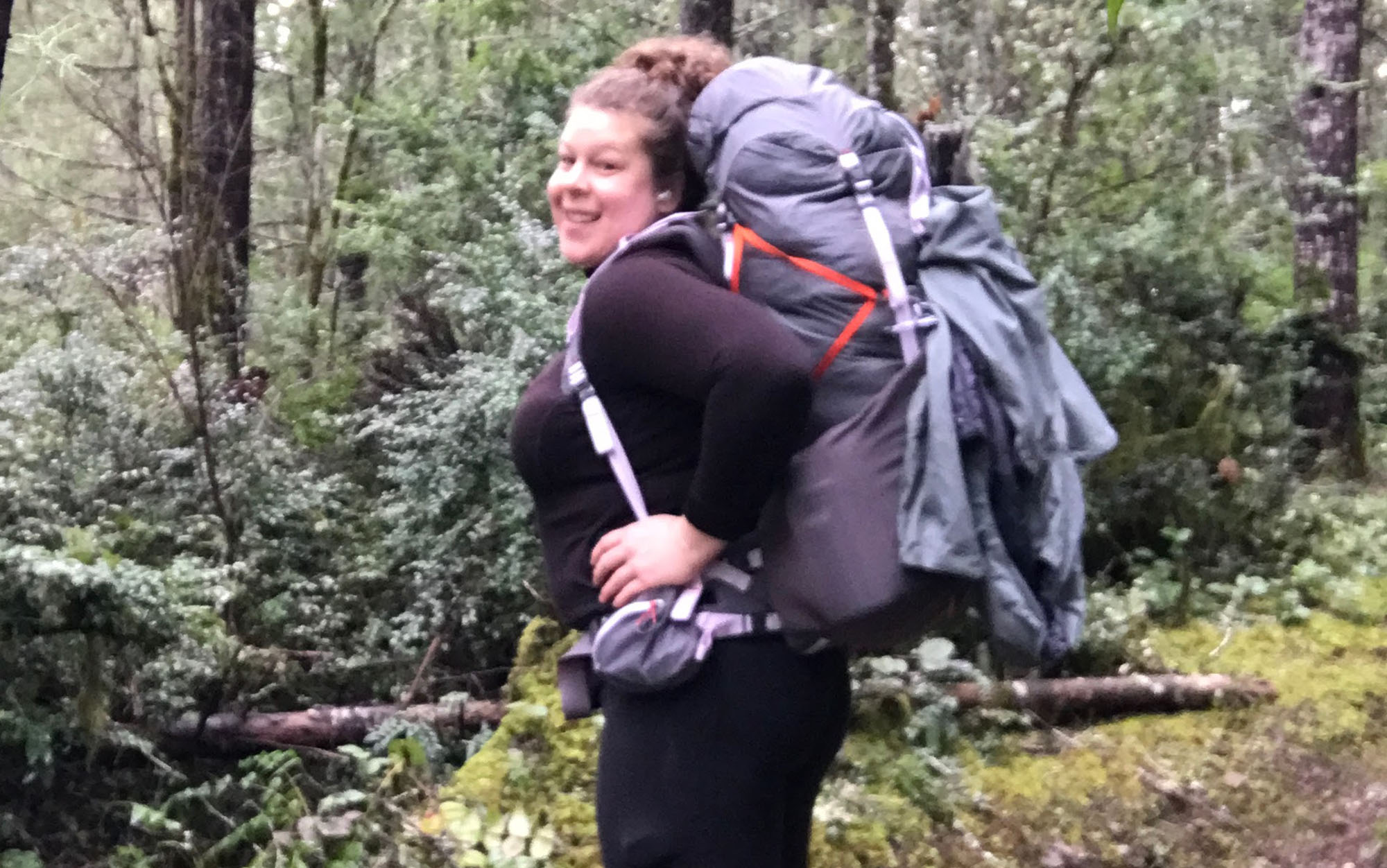
Similar to the Deuter Aircontact, both Diana and Rebecca reported that the top of the Big Agnes Garnet was hitting their head. There are two likely causes for this. For individuals with shorter torso lengths, like Rebecca, it’s possible that the high-seated fit of the Big Agnes Garnet puts the shoulder straps too high up their frame. By pulling down on the load lifters to secure the pack against their back, it ends up pulling it right against their heads. Taller individuals experiencing this issue should try readjusting the pack to a smaller torso height to see if this alleviates the problem.
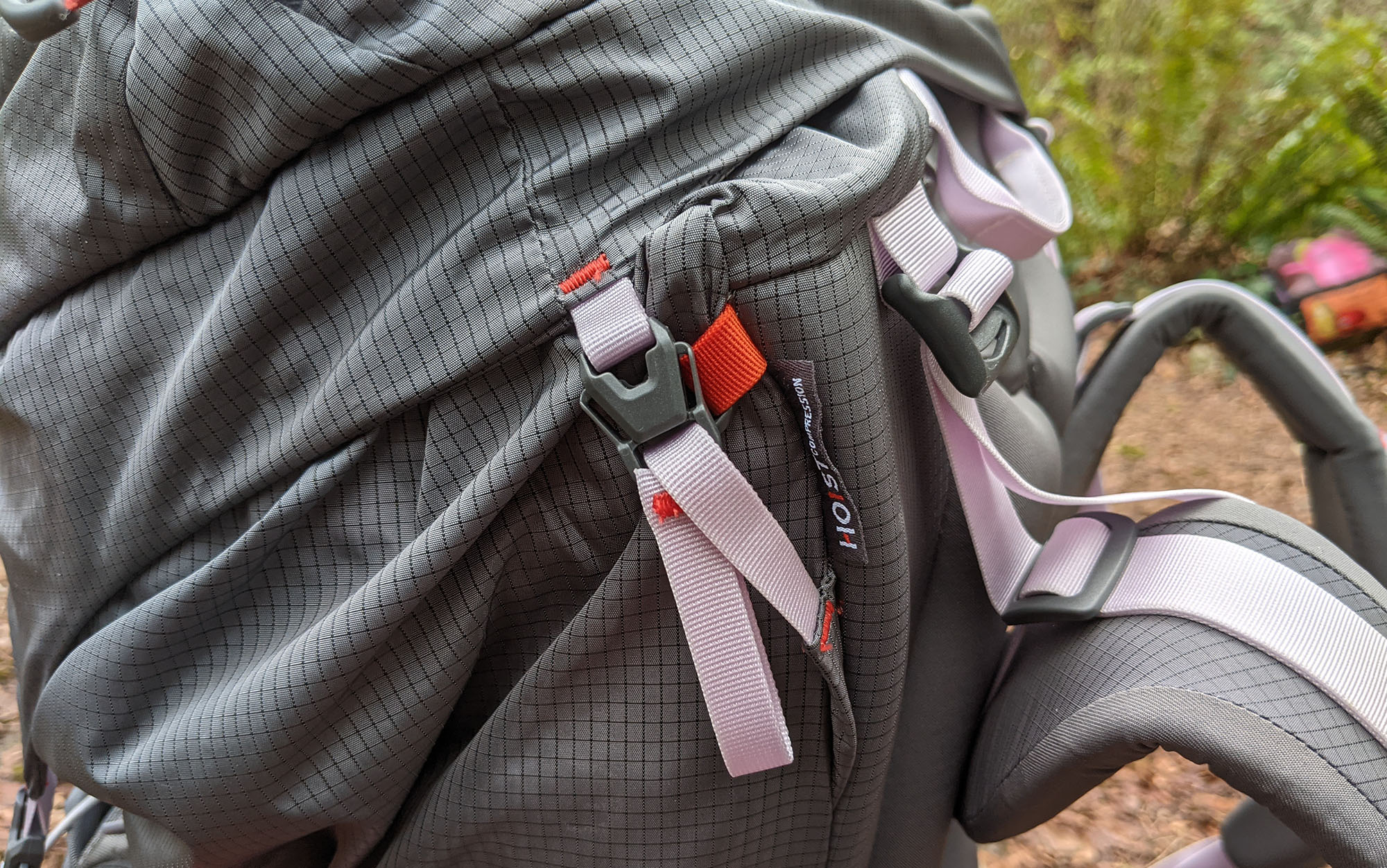
But another issue is with the removable top pocket—the so-called brain. While the pack has an additional 10 liters of space extending up the top of the frame (something our testers—who are not ultralight backpackers—made use of), the straps of the brain did not extend up very far. This meant that when the pack was fully loaded, the brain sat at a backwards tilt. To avoid this, you’ll either need to forgo the additional 10 liters of space in the main body of the pack, or use the buckles on the brain to remove it entirely.
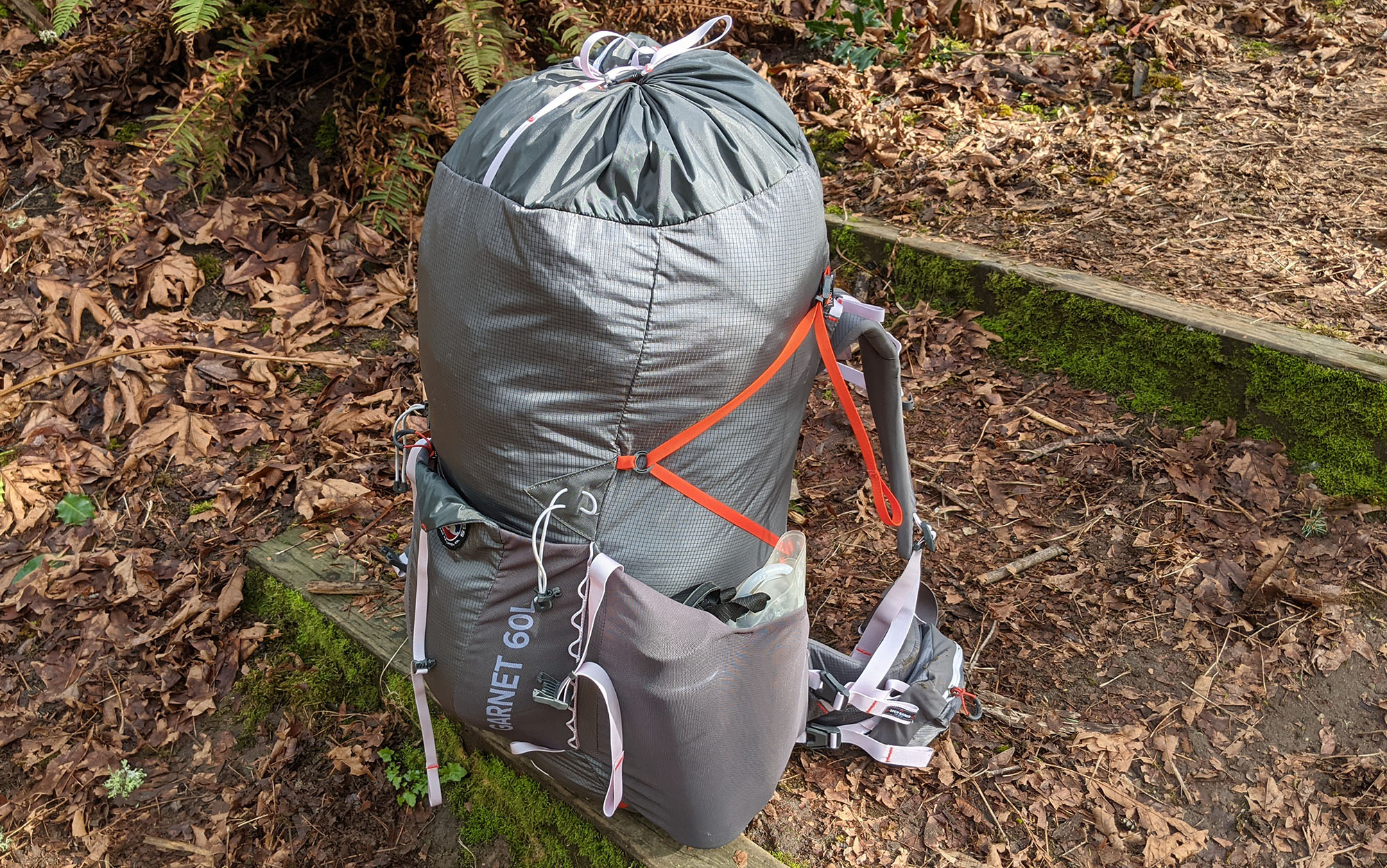
While most backpacking backpacks have a compression strap or two running horizontally across each side, the Big Agnes Parkview and Garnet has a single strap running crisscross down the side of the pack. The testers were very impressed by the level of compression they were able to achieve as a result, with Diana noting “I’ve never seen my gear look this small.” The testers also reported that even when completely stuffed, the pack was well-balanced and did a great job of transferring weight.
Storage and Accessibility
The inside of the Big Agnes Parkview and Garnet can only be accessed via the top lid (no undercarriage or side zipper access). This design choice saves on the overall weight of the pack, but it does make finding anything stashed at the bottom a real chore.
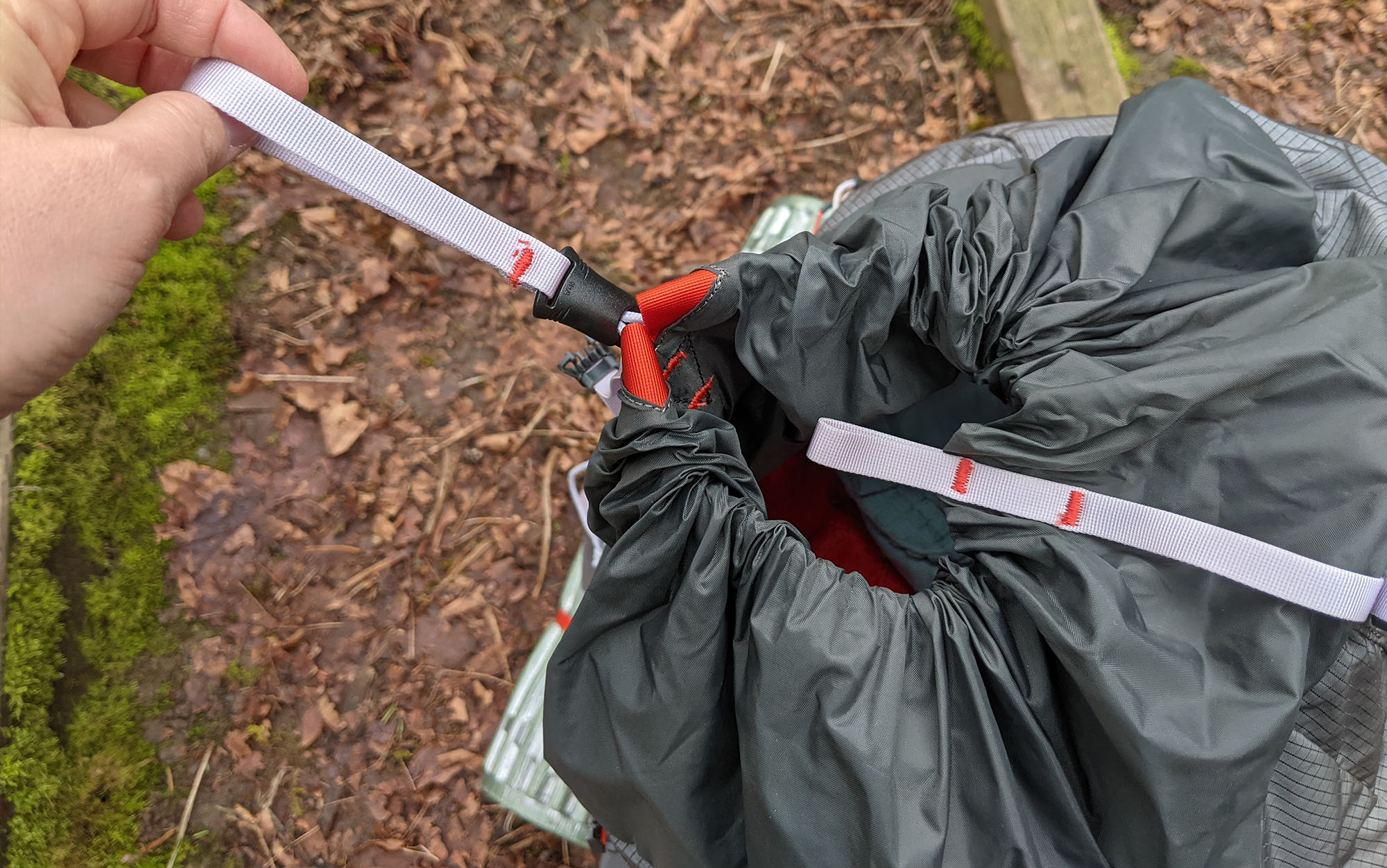
In practice, this took some getting used to for our testers, with Jason reporting that it wasn’t until his fourth trip that he really had his packing routine nailed down. “I made sure things I would need frequently were on top, in the brain, in the outside shove-it pocket, or in the side mesh pockets. I kept my food on top and my guide first aid kit just underneath my food. I kept my rain jacket and pants in the shove-it pocket, and assorted items like my headlamp, knife, and medication in the brain.”
Read Next: How to Pack a Backpack
The entry to the top of the pack is via a drawstring closure, covered by the top lid, or brain pocket. As mentioned previously, this pocket is removable, and is difficult to fit over the top of the pack when fully loaded. However, if you take off the lid, then there is nothing covering the drawstring closure at the top of the pack. For some this is more of an aesthetic concern than a functional one (unless it’s raining, of course, in which case you’ll want a rain cover), but it can give a backpacking backpack a bit of a “naked” look.
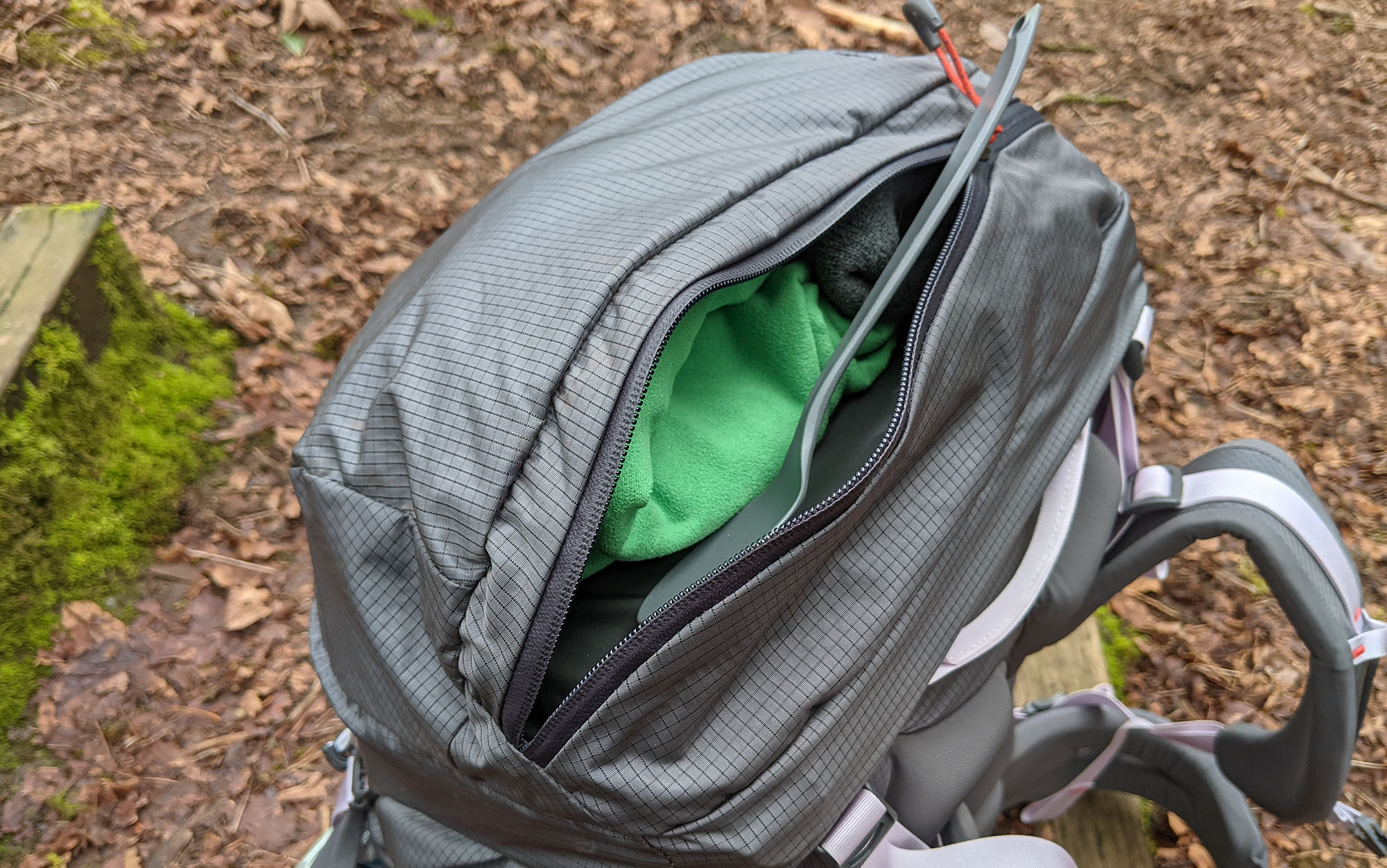
Besides being removable, the top lid is fairly standard, with a top zip and mesh bottom zip, able to hold most of the bric-a-brac you’d want to stash in there.
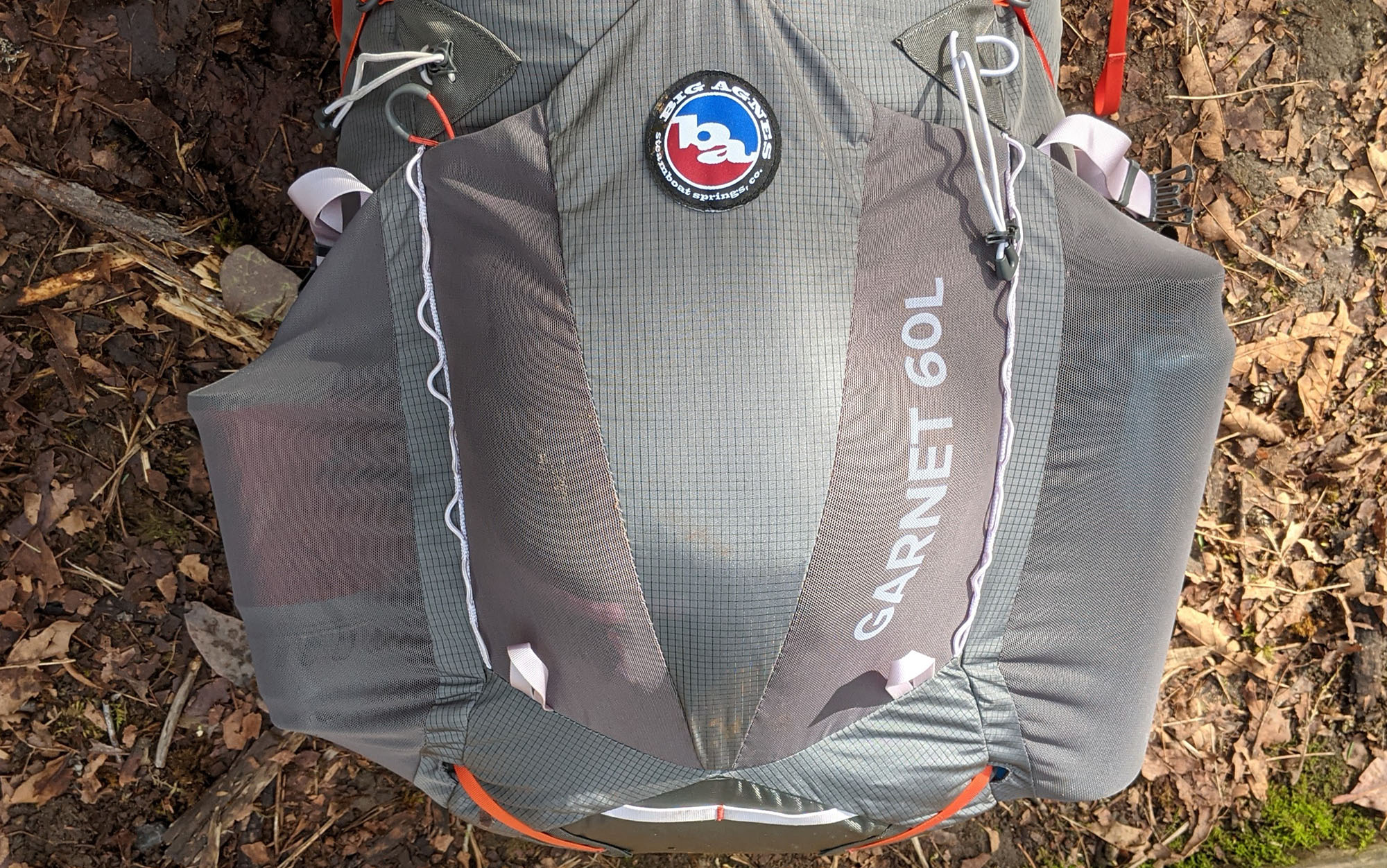
While there is some stretchy mesh on the front pocket, the majority of it is made from the same durable material as the rest of the pack. Rebecca noted that it was “smaller than most I’ve used, which restricted the amount of gear I was able to fit.” Although she appreciated “the interior mesh compartment within it, which was a good use for electronics and would keep them from falling out or getting banged up when scrambling.”
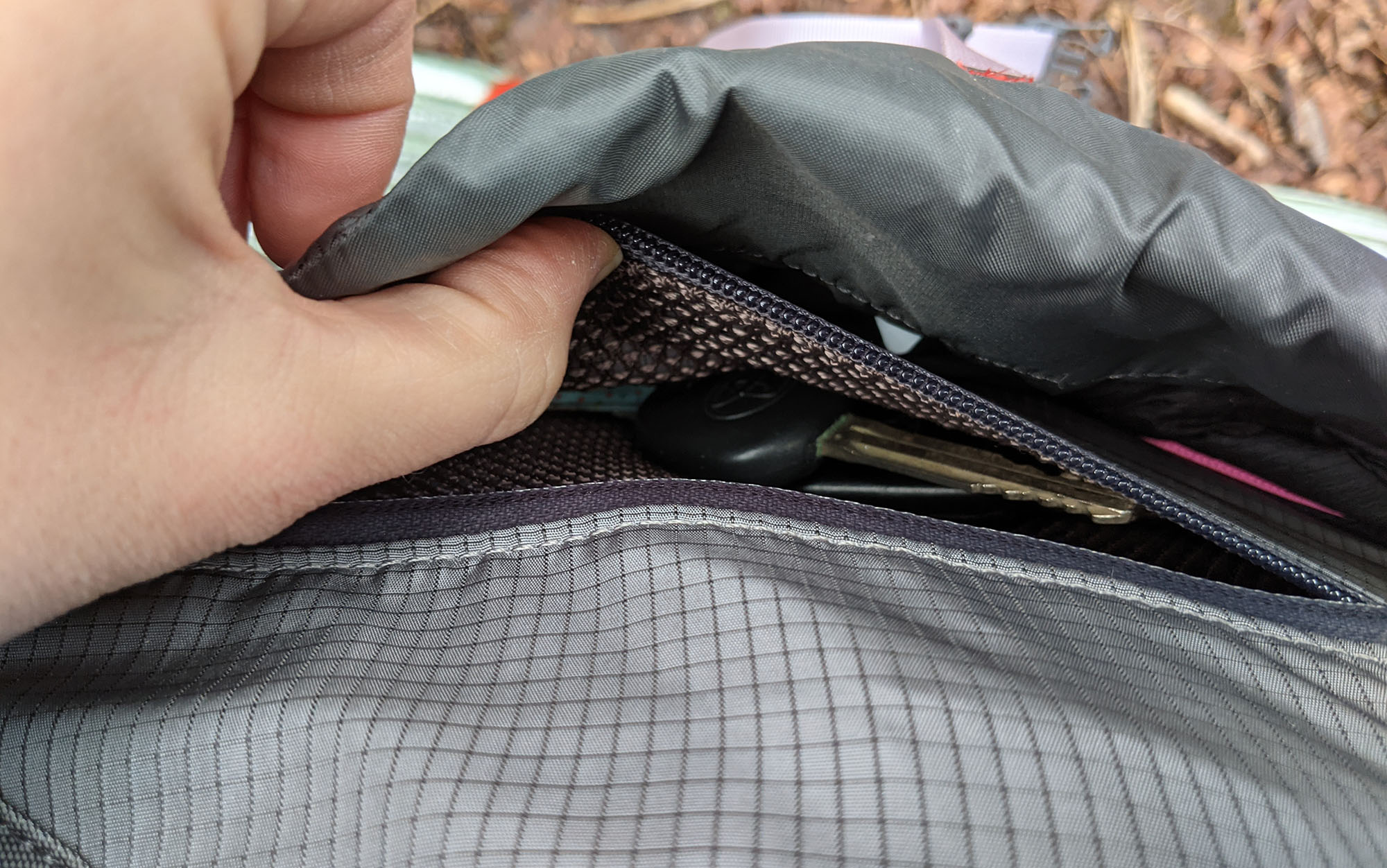
This is also an ideal spot to stash your keys or credit card in the event that you remove the top lid pocket. Other testers reported that this pocket went unused.
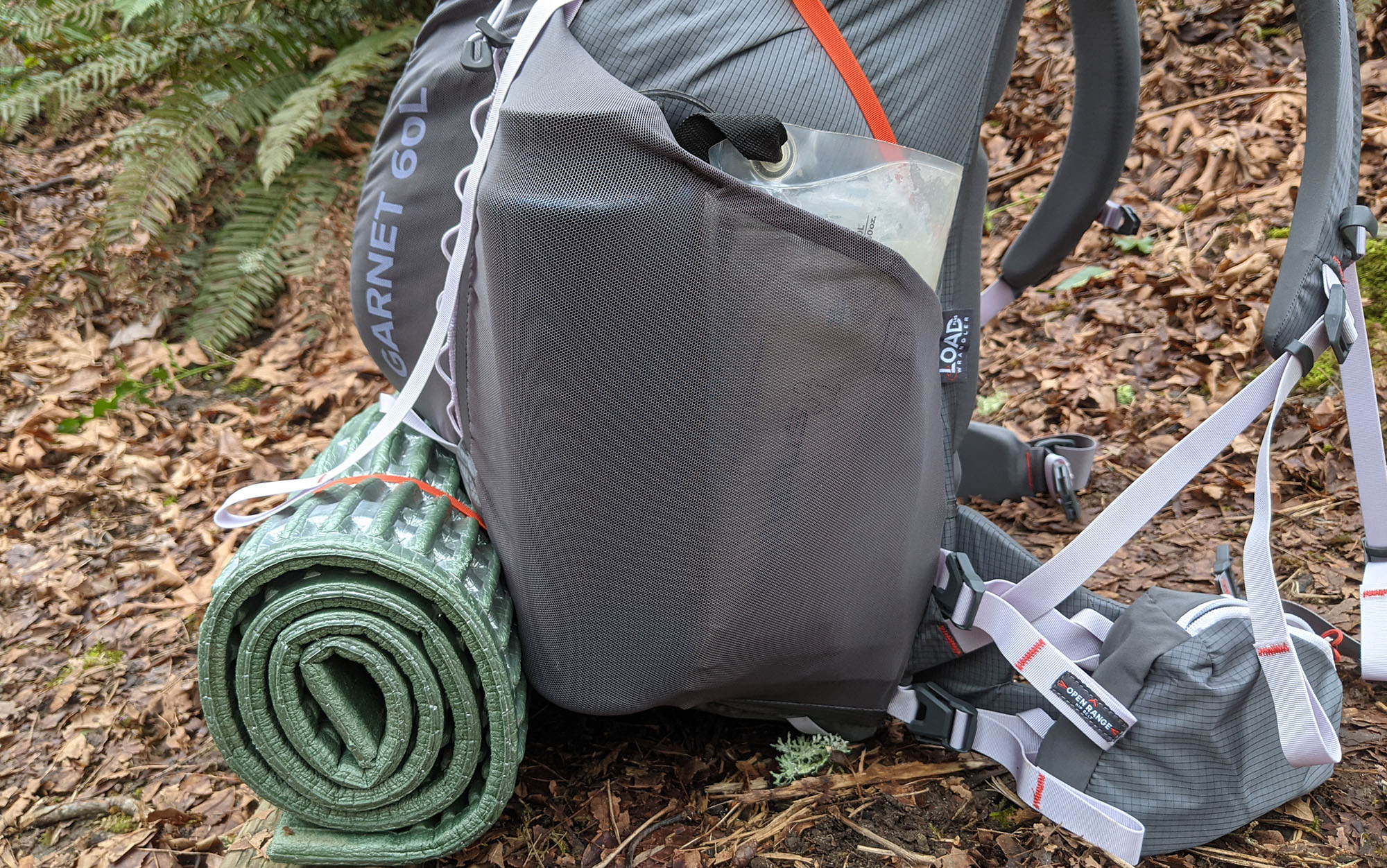
The two side mesh pockets are very roomy, and our testers were able to fit multiple items inside. Like other backpacking backpacks, the mesh used here is less durable than other parts of the backpack, with Jason noting that some small holes appeared after 130 miles of testing.
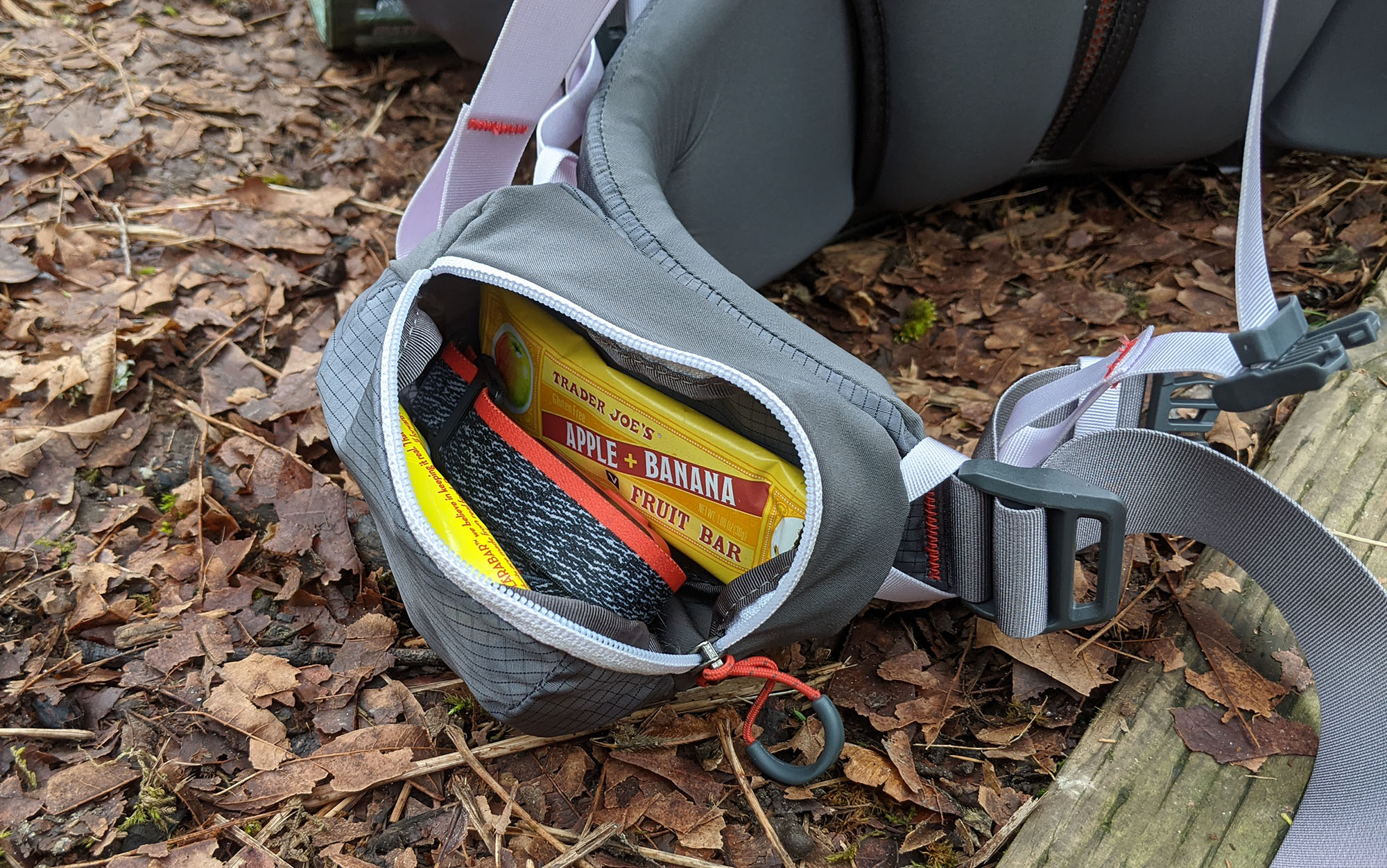
Like the top mesh pocket, the hip belt pockets are removable. While most backpackers are unlikely to remove these pockets (our testers did not), removing this plus the top lid pocket would result in a weight savings of 6.4 ounces.
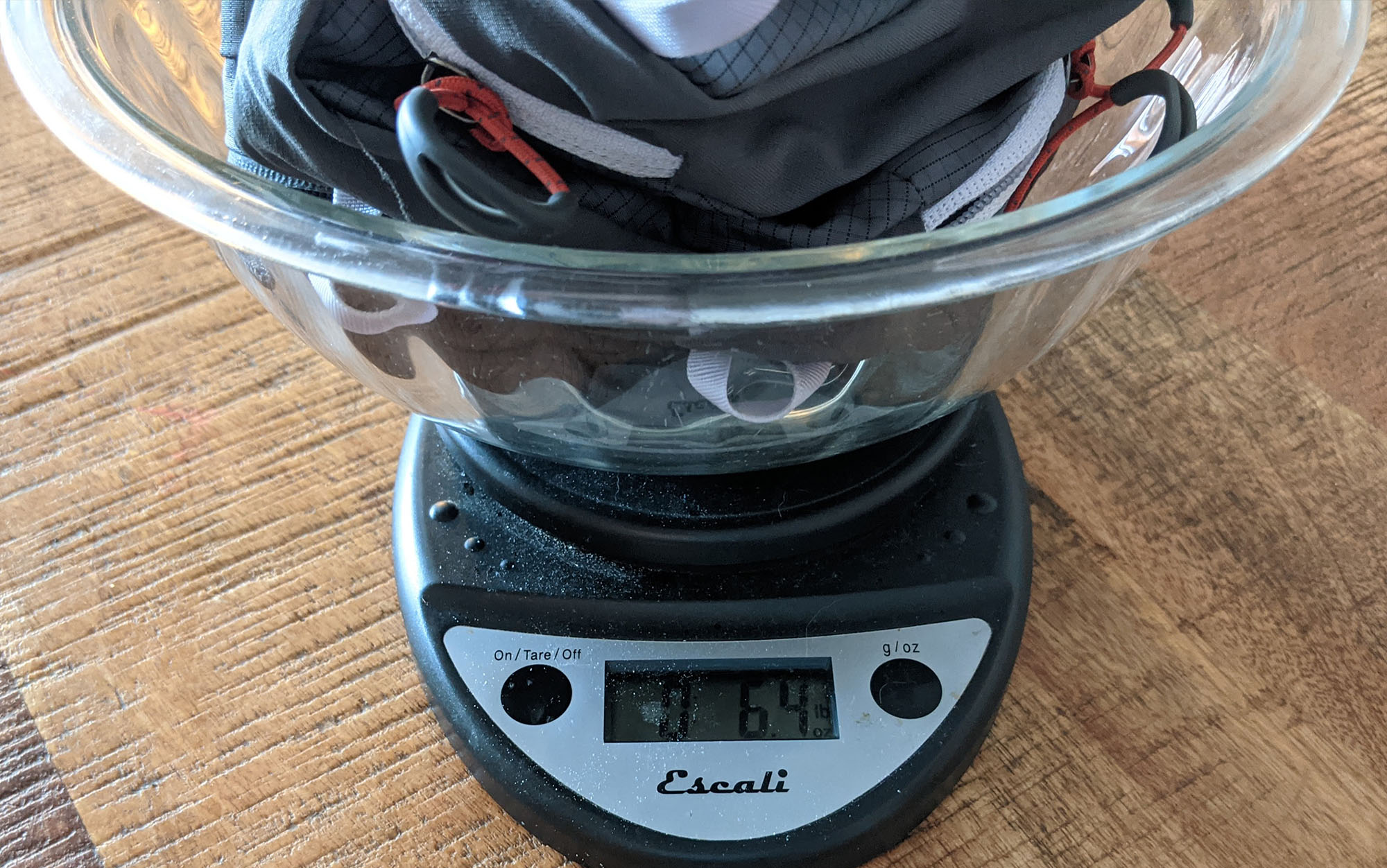
While there aren’t dedicated straps on the bottom of this pack to attach a closed-cell foam pad or tent, users with limited volume in their packs can pull the side compression straps down to use for this purpose. This is a little tricky to do in practice, particularly if the pack is on the full side, given the amount of give in the compression straps.
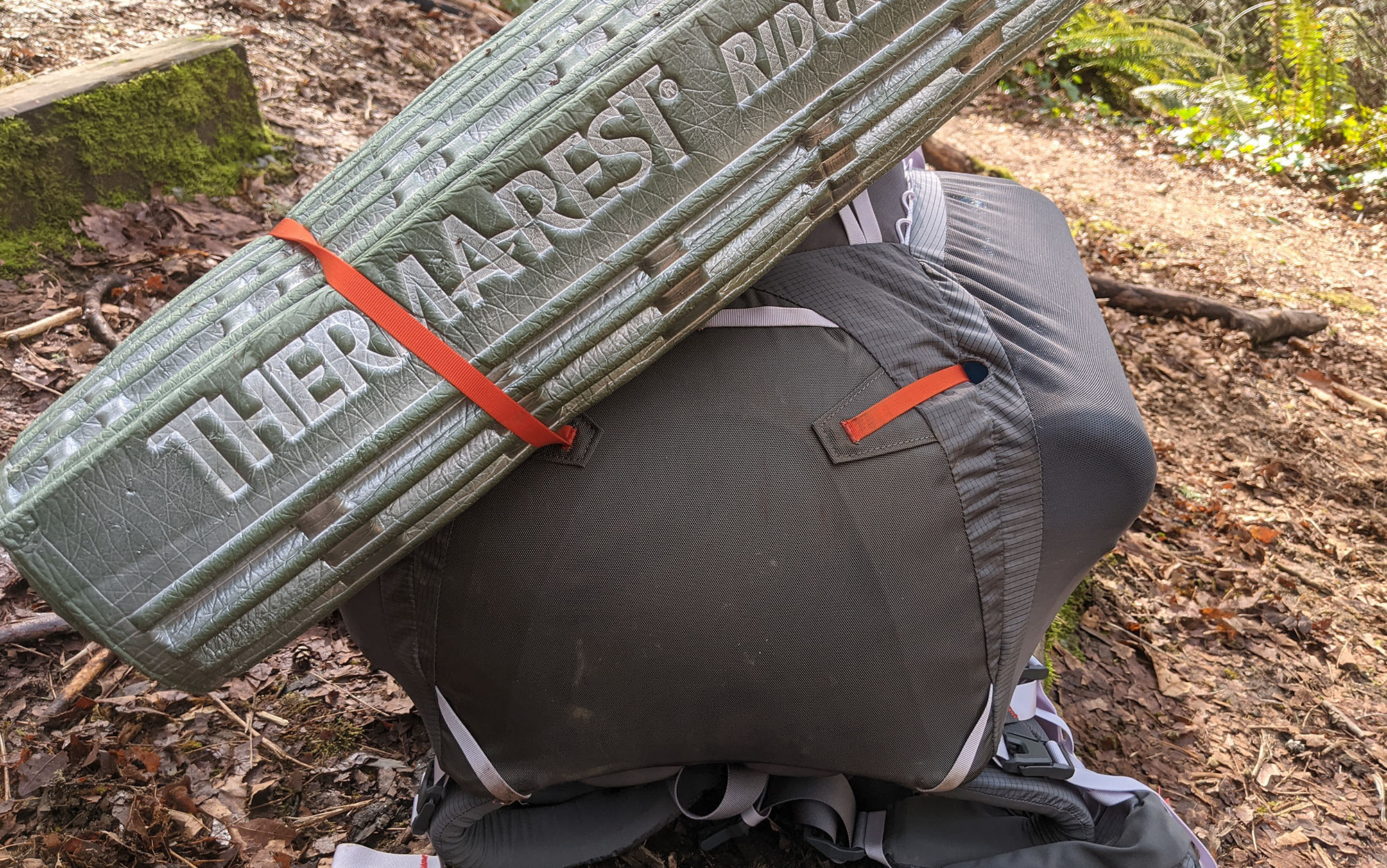
Perhaps the most unusual feature of the Big Agnes Parkview and Garnet is the 7 liter trash can that comes with it, essentially a washable nylon sack that can be attached to the outside of the pack (or just about any other). While some of our testers appreciated having a designated spot to put their trash while hiking, others felt that it wouldn’t replace the plastic trash bag they were already bringing and was redundant.
Final Thoughts
Rebecca’s Take: “This may be one of the lightest backpacks I’ve ever picked up. However, the shoulder straps put a lot of strain on my shoulders, making it feel like I had been hiking for days, not hours.”
Diana’s Take: “The load lifters made the weight feel like it was floating on me, but the arm straps were digging painfully into my shoulders and armpits.”
Jason’s Take: “The load transfer system and shoulder straps/hip belt system works and distributes weight well. My only nitpicks are the buckles are small and can be difficult to open, and the limited adjustability of the back panel.”
The Big Agnes Parkview and Garnet weigh pounds less than other traditional backpacks, but with a substantially better load-carrying capacity. This may interest guides looking to lighten their load, as well as traditional-style backpackers interested in paring down their kit, but who aren’t ready to commit to a sub-20 pound base weight.
Because the trail-fit of this pack varied (and was frequently problematic) for our testers, it’s worth setting aside some time to get this pack dialed into the right settings with a full load before hitting the trail, as you may find that you need to adjust the straps with the back panel, or even the difficult to adjust load-lifter connection points. The limited sizing options for the Garnet version of this pack may also mean that it is poor fit for individuals with longer or shorter torsos than is the norm.
